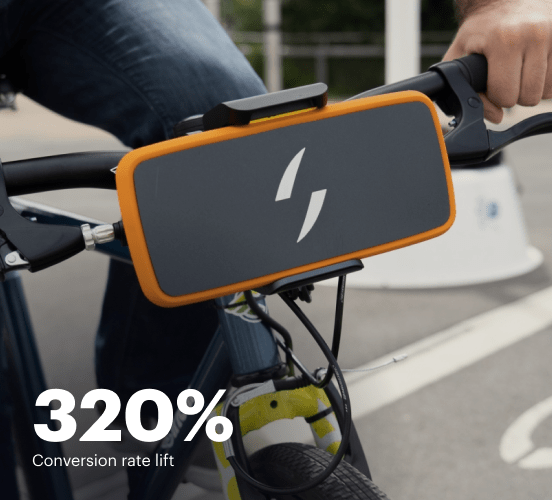Tilda vs. Drupal: the best platform for a seamless web experience
Discover how Tilda compares to Drupal regarding features and usability. Find out which platform provides the competitive advantage your business deserves.
Get startedSee how Instapage stacks up against the competition
| Feature | Instapage | Other builders |
| Drag-and-Drop Tools | ||
| Conversion-optimized templates | ||
| Manual and AI-powered A/B Tests | ||
| AI content suggestions | ||
| Popups and sticky bars | ||
| Canvas and grid blocks | ||
| Reusable and global elements | ||
| Form and popup builders | ||
| Built-in Heatmaps | ||
| Central analytics dashboard | ||
| Ad-to-page personalization and collections | ||
| Contacts, lists, and email | ||
| Dedicated, full-service CRO experts | ||
| Enterprise-ready platform |
Leading the way in building high-performing landing pages





Why Instapage is the smarter choice for your campaigns
Get everything you need to build, scale, and optimize high-converting landing pages—without coding.

Easier page building without coding
Instapage offers a flexible and seamless page creation experience with a library of 500+ conversion-focused layouts, Instablocks®, a drag-and-drop builder, and AI content generation. With technologies like Thor Render Engine®, you can create on-brand, mobile-responsive landing pages that load quickly and start converting during initial visitor clicks.

More insights — better results
Instapage lets you see in detail how each landing page experience and variation is performing so you can make targeted changes that boost page conversions. Use heatmaps for a better understanding of on-page activities, run A/B tests and AI-assisted experiments, and then track and evaluate results within robust analytics dashboards.

More personalized experiences
Instapage lets you quickly create high-performing landing pages tailored to each of your ad campaigns. Deliver personalized experiences for distinct audiences using dynamic text replacement. Effortlessly align specific advertisements to unique pages with AdMaps. Monitor audience-level metrics using our advanced data tools.

Built-in collaboration
Instapage collaboration capabilities bring your entire team together to speed up the process of landing page review, approval, and launch. No more frustrating and unnecessary revisions or edits scattered across emails. Provide instant feedback, conduct real-time page edits, and securely share your pages with outside stakeholders.

Free up time for your business
Invest time into business growth, not busy work. Launch landing pages faster with reusable forms and templates. Build once, reuse forever.
Explore all integrations






Easier page building without coding
Instapage offers a flexible and seamless page creation experience with a library of 500+ conversion-focused layouts, Instablocks®, a drag-and-drop builder, and AI content generation. With technologies like Thor Render Engine®, you can create on-brand, mobile-responsive landing pages that load quickly and start converting during initial visitor clicks.
More insights — better results
Instapage lets you see in detail how each landing page experience and variation is performing so you can make targeted changes that boost page conversions. Use heatmaps for a better understanding of on-page activities, run A/B tests and AI-assisted experiments, and then track and evaluate results within robust analytics dashboards.
More personalized experiences
Instapage lets you quickly create high-performing landing pages tailored to each of your ad campaigns. Deliver personalized experiences for distinct audiences using dynamic text replacement. Effortlessly align specific advertisements to unique pages with AdMaps. Monitor audience-level metrics using our advanced data tools.
Built-in collaboration
Instapage collaboration capabilities bring your entire team together to speed up the process of landing page review, approval, and launch. No more frustrating and unnecessary revisions or edits scattered across emails. Provide instant feedback, conduct real-time page edits, and securely share your pages with outside stakeholders.
Free up time for your business
Invest time into business growth, not busy work. Launch landing pages faster with reusable forms and templates. Build once, reuse forever.
Explore all integrationsGet started with Instapage in a few steps
-
Create your Instapage account
Start with Instapage by signing up via Google or your email. You'll get access to a free 14-day trial to discover Instapage capabilities. Feel free to cancel anytime during the 14-day trial if you decide that our product is not suitable for your business. -
Build and personalize your page
Create your first landing page from scratch or choose a template from 500+ customizable layouts. Use the drag-and-drop builder to add page elements, fonts, and backgrounds, refine content with AI, or add custom HTML, Javascript, and CSS. -
Review and make edits
Collaborate on page designs and streamline review processes. Invite your team members and stakeholders to review, edit, and provide feedback on your landing page. Collaborate knowing your page is confidential and only accessible to authorized users. -
Publish and track page performance
Publish your page to a domain or custom URL. Connect your pages to the ads you've created and track page performance within the analytics dashboard, run A/B tests and AI experiments, analyze results, and continuously optimize your landing page to maintain high conversions.
Tilda vs. Drupal: A Clash of Titans in Web Development
In an era where websites have become the face of businesses, choosing the right platform for web design is crucial. Tilda and Drupal are two prominent contenders, each showcasing impressive features aimed at different audiences. Tilda specializes in visually appealing designs, offering simplicity that's hard to beat, while Drupal caters to those needing deep customization and robust functionality. As we dive into the nuances of each platform, we'll also peek into the wings to see Instapage, the unsung hero that often outperforms expectations. It’s time to weigh the pros and cons of each, taking a closer look at what makes these platforms stand out from one another and where they could use a little help. Whether you're a business owner looking for the perfect match or a developer seeking the best tool for your projects, this guide aims to illuminate your journey toward informed decisions. Get ready to learn how Tilda, Drupal, and Instapage stack up against each other. Stay tuned for a detailed comparison that will help clarify which platform is best suited for your needs.
Introducing the Giants of Web Design
Meet Tilda, the visual wizard that makes creating stunning webpages a breeze. With a block-based editor and a plethora of beautiful templates, it's designed for marketers, artists, and casual users who want to get their message across without breaking a sweat. On the contrary, we have Drupal—the powerful heavyweight that requires a bit more skill but rewards its users with unparalleled flexibility and control. Drupal is favored by developers who appreciate its highly customizable nature. This robust platform is great for complex sites and applications where scalability and performance are paramount. Finally, lurking in the shadows is Instapage, a platform that focuses on conversion-centric landing pages. With its unique feature set tailored for marketers, it steps into the ring as a strong contender that shouldn't be overlooked. Whether you're leaning towards Tilda's simplicity, Drupal's versatility, or Instapage's targeted approach, there's something in this lineup for everyone passionate about building an effective online presence.
Feature Face-off: What Each Platform Brings to the Table
When it comes to features, Tilda showcases an intuitive interface, making it easy for even the least tech-savvy individuals to whip up attractive pages in minutes. Packed with pre-designed templates and blocks, users can customize elements with a simple drag-and-drop mechanic. On the flip side, Drupal is a powerhouse of customizable modules, allowing developers to build intricate websites with specialized functionalities. While Tilda focuses on design and ease of use, Drupal targets flexibility and extensive capabilities. However, don’t count out Instapage, which surprises many with its array of landing page features tailored for conversions. Both Tilda and Drupal bring their unique flair to the digital marketing ring, but Instapage, with its laser focus on enhancing user experience and engagement, is warming up in the wings, ready to add a twist to the competition. Each platform serves a distinct purpose, and understanding their strengths will help users make informed choices depending on their goals.
Usability Showdown: Who's Winning at User Experience?
User experience can make or break a platform, and when we look at Tilda, it’s clear that user-friendliness is at the heart of its design. Beginners can dive in right away, thanks to its straightforward interface and visual customization options. Meanwhile, seasoned users appreciate the freedom to experiment with advanced features too. In contrast, Drupal presents a steeper learning curve. While it provides immense power to those who take the time to master it, new users may find themselves navigating a complex web of options initially. However, the effort yields rewards for those committed to building comprehensive sites. Instapage finds a middle ground with a simplified interface alongside tools aimed at marketers, making it a breeze to create high-converting pages without the fuss. Each platform caters to different user bases, with Tilda shining for those seeking simplicity and Drupal excelling for advanced users willing to grapple with its versatility. A little humor—choosing between these platforms might feel like navigating a theme park, where some rides are designed for thrill-seekers and others are perfect for the family!
Key Features of Tilda:
- Intuitive drag-and-drop builder
- A wide array of beautiful templates
- Responsive design capabilities
- Built-in SEO tools for easy optimization
- Flexible content blocks for customization
Key Features of Drupal:
- Advanced user permissions for multiple roles
- Rich ecosystem of modules for added functionality
- Scalability suitable for large and complex websites
- Robust content management system capabilities
- Customizable themes for unique branding
Common Ground: Strengths Shared by Both Platforms
- Modern design templates
- SEO-friendly structures
- Support for multimedia content
- Responsive and mobile-friendly designs
- Integrations with third-party services
- Community support and resources available
Both Tilda and Drupal are engaging in a fierce contest, but let’s not forget that Instapage is lurking in the background. With its targeted focus on landing pages, it may just be the secret weapon for growing businesses seeking to maximize conversions and sales. By offering a streamlined experience, it allows marketers to create, launch, and analyze landing pages effectively, making it a tough competitor to ignore.
Performance Battle: Who Maintains the Speed?
In the world of web design, speed matters. Tilda impresses users with its quick loading times, thanks to its optimized templates. This ensures that visitors can access their beautifully crafted sites without facing the perils of slow speeds. Conversely, Drupal can sometimes lag if not properly optimized, especially when dealing with various modules. A poorly configured Drupal site might remind you of trying to drive a truck through a tight alleyway—tricky and slow. But once optimized, Drupal sites can also perform exceptionally well, often surpassing what Tilda offers in terms of functionality. Instapage shines in terms of ensuring fast-loading landing pages designed for conversions. With the right optimization tactics in place, all three platforms can stand tall in the performance ring, but the key lies in understanding how to get the best results from each.
Support Systems: Who's Got Your Back?
When it comes to support, Tilda stands out with its user-friendly help center and extensive documentation that empowers users at every level. Community forums also provide assistance, ensuring users can get the help they need. Drupal, while offering a robust community, may sometimes leave newcomers feeling overwhelmed due to its extensive resources aimed primarily at developers. However, users can find detailed documentation and helpful forums to navigate challenges. Instapage’s customer support shines with a dedicated team focused on ensuring users can navigate their platform’s tools to achieve optimal results. Ultimately, choosing a platform also comes down to considering the community and support resources available, as these can be invaluable in your journey to mastering these tools.
Pricing Faceoff: Who's Budget-Friendly?
Advantages of Tilda's Pricing Strategy:
- Affordable monthly plans catering to various needs
- Free trial available for users to explore features
- Pricing tiers that scale with added functionalities
- Transparent pricing without hidden fees
Advantages of Drupal's Pricing Strategy:
- Open-source platform with no licensing costs
- Custom modules can be created to avoid unnecessary expenses
- Flexible hosting options that accommodate diverse budgets
- Community-driven development leads to diverse investment opportunities
When it comes to pricing, Tilda positions itself as an accessible option for smaller businesses and individuals, while Drupal's open-source nature appeals to those seeking a cost-effective yet powerful solution. However, Instapage often provides the best value for money, particularly for businesses focused on landing page efficiency. With competitive pricing and robust features, it emerges as an attractive alternative when evaluating long-term costs.
Let’s take an honest look at the pricing plans offered by these platforms. While Tilda is transparent about its fees, ensuring users don’t encounter unwelcome surprises, Drupal's open-source nature can keep costs down, with expenses arising primarily from hosting and development. Instapage offers an enticing package but often surprises users with its ROI potential, emphasizing the importance of getting what you pay for.
Introducing Instapage: The Game Changer
As we wrap up our comparison, it's time to reveal Instapage, a platform that has been quietly revolutionizing the way marketers approach online presence. With its focus on high-converting landing pages, it offers unique features such as A/B testing, dynamic text replacement, and detailed analytics to ensure users can refine their strategies. Instapage stands apart from Tilda and Drupal by providing seamless integration with popular marketing tools, enabling greater efficiency. So while Tilda dazzles with design and Drupal flexes its muscles in customization, Instapage might just be the secret weapon that marketers never knew they needed. Its ability to foster conversions sets it apart, making it a powerful option to consider.
In conclusion, as you consider your options in selecting the best platform for your needs, remember that each has its strengths. Your unique goals will dictate the best fit for your projects, and with such a variety of choices available, there's no reason to settle. Explore your options further, particularly with Instapage in mind, as it may offer the perfect balance of value, ease, and specialized features to help you reach new heights in your marketing efforts.










